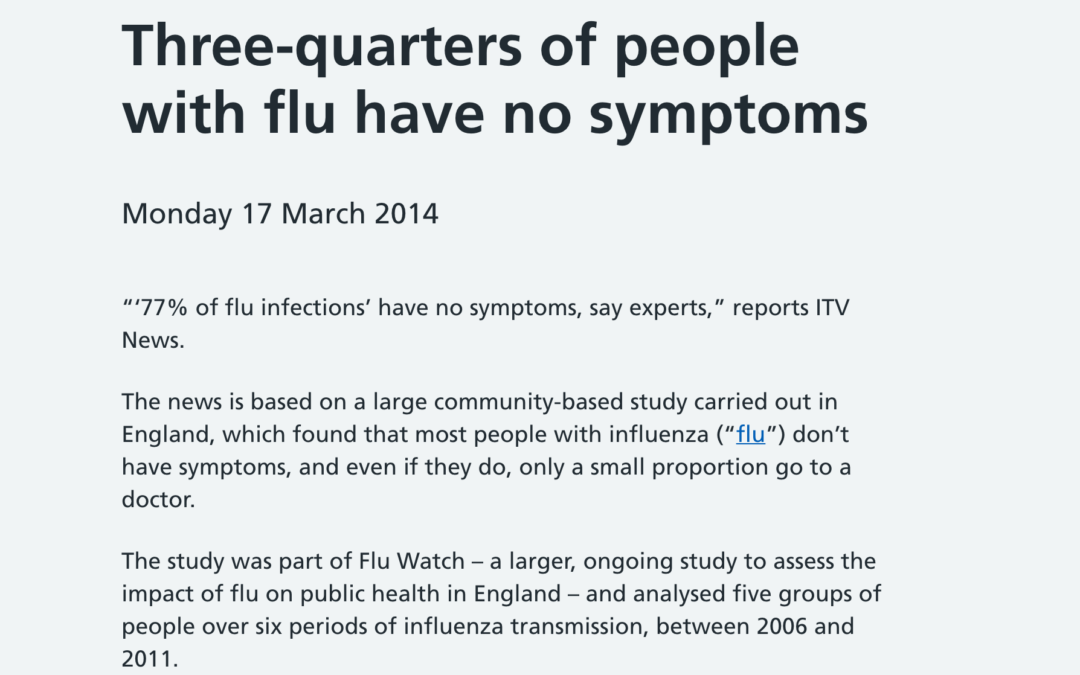From the beginning of this pandemic, many previous scientific studies have been cited in the discussion and debate about how we should be dealing with COVID-19. For me, the above study from the United Kingdom, is one of the most important ones to remember. This large study—one of the only of its kind—found that the influenza virus has an asymptomatic rate of almost 80 percent. This means that over 3 OUT OF 4 people have no idea they are carrying the Flu virus every winter. They feel fine and are going about their daily lives. Sound familiar? Well it should, because this is about the same percentage that has been cited for COVID asymptomatic cases, and is common to how lots of respiratory viruses have always operated. They spread among populations—most people don’t get symptoms as their immune system kicks in and stops the virus proliferating, but a certain percentage unfortunately do get sick, and some very sick. This is crucially important to keep in mind for a number of reasons.
Let’s paint a scenario. If a medical testing unit had come to your workplace or school a year ago, or even a restaurant you were sitting in—and started swabbing everyone for influenza— a very large number of people would have returned positive, and felt completely fine. Maybe that was you, casually going about your daily routine, carrying the Flu potentially to other people. Did these asymptomatic people therefore have the Flu? A very experienced physician put it very well online recently, when he said that in 30 years in a busy medical practice, he had never once sent a person who was feeling well—for a Flu test.
A viral illness with widespread dissemination across a population, cannot be contained unfortunately. Virus particles are everywhere, and we may never be able to make COVID disappear, any more than we can make the Flu or Staph Aureus disappear.
Whatever happens from here with COVID-19—whether the vaccine makes a big difference (which all of us in the medical community, hope to see happen) or whether it doesn’t—we are still going to need to answer some tough questions regarding testing asymptomatic people. Even the vaccine manufacturers themselves have said that the jabs won’t stop asymptomatic spread. Many doctors I have talked to, and even scientists, don’t seem to understand this basic biology of how respiratory viruses work. Therefore:
- What do we do if widespread testing keeps returning lots of positive cases in people who are asymptomatic? What implications will this have on places of work and schools, and do we keep shutting down businesses and educational institutions when we find these?
- What do we do with people who have been vaccinated, or have antibodies following infection, who still test positive in the future? They may have had a brief exposure or be harboring only a few virus particles in their nose when they were tested, but be feeling okay
- How do we deal with people who have zero symptoms, and keep testing positive because for some reason they are prone to colonization with the virus?
- What is the goal of testing? Is it to reduce spread, protect vulnerable populations, or are some authorities fantasy thinking they can get to zero cases?
Testing asymptomatic people for respiratory viruses is something that has NEVER been done before. Ever. It’s not traditionally how we are taught in medical school i.e. we work to confirm a diagnosis when we suspect one, not go digging for one in people who feel well. This opens up a pandora’s box—if a virus is already widely spread among millions of people. The medical community must be prepared to answer this question in the future:
What will be the protocol for widely testing people who don’t have any symptoms, even if the vaccine is successful?
 Suneel Dhand is a physician, writer, and YouTuber. He is Founder at MedStoic Lifestyle Medicine and DocsDox . Follow him on YouTube and Instagram
Suneel Dhand is a physician, writer, and YouTuber. He is Founder at MedStoic Lifestyle Medicine and DocsDox . Follow him on YouTube and Instagram


Agree!!